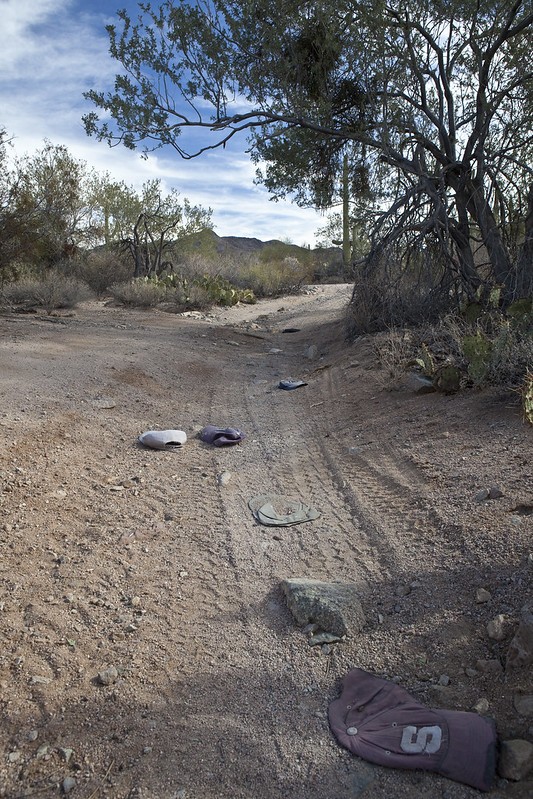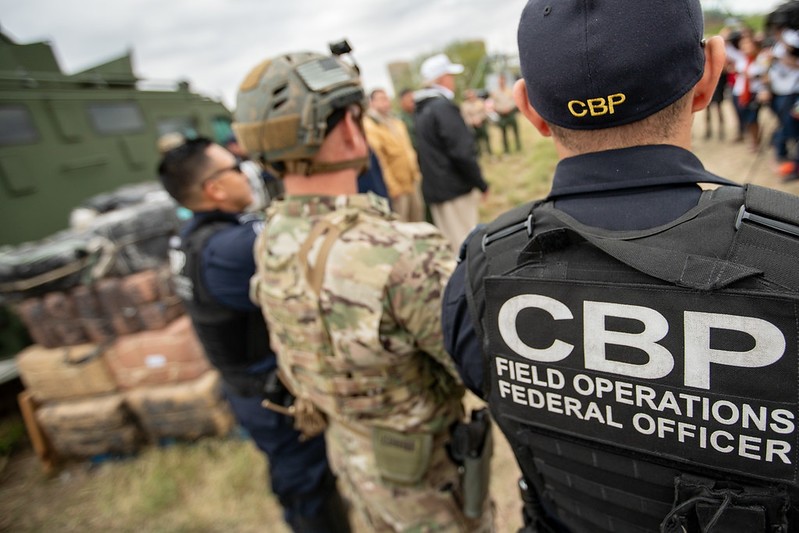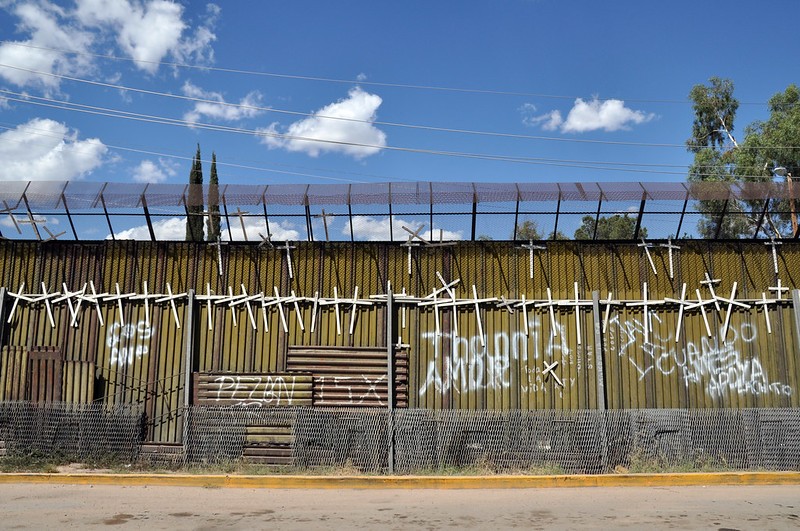“Wall of Crosses in Nogales” by jonathan mcintosh is licensed with CC BY 2.0. To view a copy of this license, visit https://creativecommons.org/licenses/by/2.0/
The Bones in the Valley
There are bones in the valleys of the Sonoran Desert. There are thousands of them. In 1994, the United States government implemented a new enforcement strategy for the Southwestern border. It was designed to prevent illegal entries by raising the costs of crossing to unbearable levels. If migrants judged the cost to outweigh the benefits, planners supposed, they would never undertake the journey in the first place.
In the intervening years, the border environment itself has become the primary technology for raising and extracting the cost. This development was no accident. High-ranking officials with the Immigration and Naturalization Services and US Border Patrol observed that the Sonoran’s extreme heat and imposing terrain exposed migrants to “mortal danger,” and sought to force migrant traffic between ports of entry and “over more hostile terrain, less suited for crossing and more suited for enforcement.”1 Any perceivable benefit to crossing would lose its motivating force when weighed against the likelihood of one’s demise. The strategy counted for its deterrent effect upon the production and reproduction of death–upon an ever-growing ledger of the dead.
Whether the strategy has succeeded in deterring unlawful entries is unclear. Whether it has increased the incidence of migrant mortality cannot be doubted.

Since the strategy’s implementation, the Tucson sector, which falls within the Sonoran Desert’s vast expanse, has become one of the deadliest places to cross the border. In Pima County alone, it has produced more than 3,300 human remains. Prior to the strategy’s implementation, automobile accidents were the leading cause among the small number of migrant mortalities. Following its implementation, exposure quickly took over the lion’s share of a ballooning number of deaths.
The steadily growing ledger of the dead counts not only the cost that migrants pay in crossing, but the human cost at which the American project of self-determination is secured. Political philosopher Michael Walzer proposes that political self-determination finds its deepest expression in the decisions of admission and exclusion by which a society determines its shape.2 In the Sonoran Desert, the drama of migration and border policing reveals the everyday practices by which the United States attempts to secure its power to make these decisions. Yet, on the border, a political community that praises the ideals of liberty and equality, secures these ideals for some through policing practices that preclude the possibility of their attainment for others.
“Sonoran Desert National Monument” by BLMArizona is marked under CC PDM 1.0. To view the terms, visit https://creativecommons.org/publicdomain/mark/1.0/
In a further twist of bitter irony, by deputizing the natural environment as its principle agent, our present border policing strategy not only constrains migrants’ agency but implodes national agency as well. In thousands of cases, it is the desert that decides who is admitted and excluded. It is the desert that decides the shape of American character. Escaping this vicious trap requires attending to the witness that the bones bear against us and, in so doing, coming to terms with the agency of the dead.

The Specter of Violence
The use of lethal means for purposes of exclusion requires equally strong justifications. Thus, for decades, the federal government has conceived and portrayed the borderlands as a theater of conflict. In 1994, when the strategy was designed, border enforcement officials worked in concert with experts from the Army’s Center on Low-Intensity Conflict. The language of “low-intensity conflict” (LIC) is meant to describe a level of conflict higher than the normal competition between states but lower than conventional warfare.3 If LIC fails to bear the marks typically associated with conventional warfare, it is to be identified by the clash between the belligerents’ antithetical ideologies and principles. While these clashes may be localized, according to the doctrine of LIC, they bear national and even global security implications. Border enforcement’s ostensibly existential stakes have been reflected in the accumulation of military technologies on the border. Since 1994, but especially in the years following the terrorist attack on the World Trade Center in 2001, border enforcement has increasingly adapted for its own purposes technologies initially designed for battlefields.4 These technologies include seismic and acoustic footfall sensors on the ground, and Predator drones in the air.

In April of 2017, former Attorney General Jeff Sessions evoked the specter of violence in prepared remarks delivered to officers of US Customs and Border Protections. He described the border as “ground zero” in the fight against “criminal organizations that turn cities and suburbs into warzones.” “On this sliver of land,” Sessions declared, “we take our stand against this filth.”5 However incongruous with the task of border policing Sessions remark might appear, they reflect USCBP’s own self-understanding as “America’s frontline,” the “guardians” who “protect the American people against terrorists and the instruments of terror.”6
“Jeff Sessions” by Gage Skidmore is licensed with CC BY-SA 2.0. To view a copy of this license, visit https://creativecommons.org/licenses/by-sa/2.0/
The characterization of the borderlands as a theater of LIC situates migrants in an aesthetic schema that promotes specific understandings of their agency and motivations that legitimize the use of lethal force. Costumed as enemy combatants, migrants appear to make a free and uncoerced decision unlawfully to enter the United States in order to undermine its political institutions. Sessions’ remarks are indicative of the perceived opposition between “law-abiding citizens” and the “filth” that would raze their world to the ground. Illegal entries and violations of specific laws are perceived as entrees to greater violence that would unmake law as such and turn our cities and suburbs into “warzones.” Set under the exigency of national self-preservation, the use of lethal force appears more palatable. That the desert is the primary agent of this force may even appear more anodyne than the image of border patrol officers repelling migrants with machine guns.
However compelling the specter of violence has been in motivating and justifying federal policies, the aesthetics of LIC perpetrate several conceits.
First, it is a stretch to describe migrants’ movements across the border as unqualifiedly free, uncoerced, or malevolent. Leaving aside the political economic “push” and “pull” factors that shape decisions to migrate, migrants attempting to enter the US face a theater of concrete constraints.7 A confluence of limited access to ports of entry, declining asylum admissions, and inequitable immigration quotas, on one side, compounded by hundreds of miles of border fencing, a burgeoning surveillance apparatus, and a constantly growing number of border enforcement personnel, on the other, contributes to many migrants’ decisions to attempt to elude detection in remote stretches between ports of entry.8 This trend is a stark change from the years preceding 1994, when movement across the border was largely unregulated and relatively simple (especially in “twin cities” like Ciudad Juarez-El Paso and Tijuana-San Diego). As for migrants’ motivations, law-enforcement personnel have conceded that many who enter surreptitiously are likely not terrorists or subversives, but individuals in search of a better life, pressed into desperate crossings by hostility at ports of entry.9
Second, it is also a conceit to suppose that by deputizing the desert, the federal government secures for the American people agency in matters of self-determination.
According to Walzer, collective self-determination brings exercises of political power in line with justice by putting them in the service of the social meanings that a people holds in common.10 In this setting, political power is made a means of a society’s self-becoming. This dynamic is crystalized in decisions of admission and exclusion. By these decisions, the present members of a society distribute this most fundamental social good according to the meaning they assign it. In this way, they claim their agency to determine who they will be and with whom they will associate.
However, when migrants’ fates are determined by the indifference of the beating sun or the hostility of an arid landscape, decisions of admission and exclusion are causally disjoined from any collective intentionality and infiltrated by a vicious arbitrariness that makes their coincidence (or the lack thereof) with social meanings purely accidental. By handing these individuals over to the wilderness, we trade any meaningful sense of self-determination for deadly apathy. Political agency, at the deepest level of self-determination, wanders into the same desolation to which the desert condemns the excluded.

The Power of Bones
In fewer than three decades, 3,300 human remains have been recovered in Pima County alone. Does any shred of agency remain among the fragments of disarticulated bones? We might be tempted to judge these bones to be the artifacts of a necro-political process that obliterates any measure of migrant agency. Achille Mbembe identifies necro-politics as an exercise of sovereign power by which the state consolidates to itself the power to let live and make die.11 However, in the borderlands, agency and its absence are not straightforwardly intelligible concepts and there is reason to believe that even the power to make die is not yet the power to unmake agents.
Agency does not belong to the living alone. The dead attain a political afterlife as they mortify LIC’s aesthetic scheme and chain political self-determination to its responsibility to the outsider.
The power that bones wield is, at first, experienced in the negative. LIC’s aesthetic scheme justifies the use of lethal power by dividing the world into attackers and defenders. It invests these characters with dispositions – criminality, lawfulness, terroristic malevolence, civilized benevolence – that make them the rightful subjects or objects of that power. However, fragmented bones do not display these dispositions. They revoke them. As they outlast the conflict’s climactic moment, the bones take on a disruptive power. Consigned to the dust, the specter of violence that once accompanied them passes away. The bones no longer pose any threat to us. Instead, they confront us with the commonality between two vulnerable contingent creatures. One remains among the living. The other shares the stillness of death. The gulf between them raises a question. It is no longer clear why one should stand among the living and the other sojourn among the dead. On what grounds has this ultimate distinction been made?
In this question, the dead reassert their demand upon the living. As Cain learned in the primordial fratricide, to slay our sibling is not to loose ourselves from responsibility for them. The bones that litter the borderlands bear no less on the shape of American character than the idealized professions of its members. The excluded, no less than the admitted, play a role in fixing and revealing the meaning of membership. At this juncture, if we will attend to their demand, the power of bones may yet bear positive effect. They signal a shift from a self-determining political subject shaped according to a principle of autonomy, to a political subject constrained by, yet responsible to the demand of another.12
The act of remembering the dis-membered bodies in the borderlands may yet precipitate the re-membering of the body politic and the transgression of its stated boundaries. At the very least, the act of remembrance allows the body politic to be haunted by the good of the lives it denies.
In the borderlands, to be haunted is to experience the moral agency of the dead.
Want to know more about this author? Click here!
Footnotes
- Doris Meissner, Border Patrol Strategic Plan: 1994 and Beyond (Washington, D.C.: United States Border Patrol, 1994), 7.
- Michael Walzer, Spheres of Justice: A Defense of Pluralism and Equality (New York: Basic Books, 1983).
- Headquarters Departments of the Army and the Air Force, Field Manual 100-20: Military Operations in Low-Intensity Conflict (Washington, D.C., 5 December 1990), 1-1.
- See Peter Andreas, Border Games: Policing the U.S.-Mexico Divide (Ithaca: Cornell University Press, 2009).
- Jeff Sessions, “Remarks Announcing the Department of Justice’s Renewed Commitment to Criminal Immigration Enforcement,” Nogales, Arizona (11 April 2017).
- “Ethos of the U.S. Customs and Border Protection Agency,” in U.S. Customs and Border Protection, Vision and Strategy 2020: U.S. Customs and Border Protection Strategic Plan (Washington D.C., Department of Homeland Security, 2015).
- See Andreas, Border Games; & Jason De León, The Land of Open Graves: Living and Dying on the Migrant Trail (Oakland: University of California Press, 2015).
- De León’s interviews with border crossers in The Land of Open Graves provide relatively candid windows into the reasoning behind migrants’ decisions in crossing.
- Department of Homeland Security, “Special Review – Initial Observations Regarding Family Separation Issues Under the Zero-Tolerance Policy,” Office of the Inspector General (September 27, 2018).
- Walzer, Spheres of Justice.
- Achille Mbembe, “Necropolitics” in Public Culture 15 (2003): 11-40.
- On the role of the demand in the formation of political and ethical subjectivity, see Simon Critchley, Infinitely Demanding: Ethics of Commitment, Politics of Resistance (New York: Verso, 2007).
